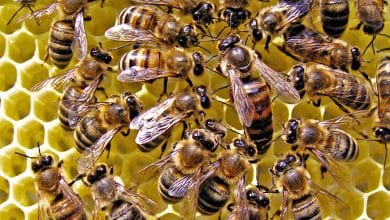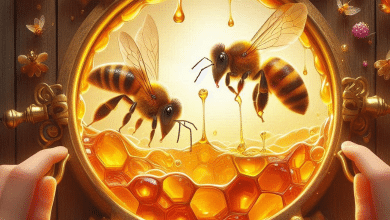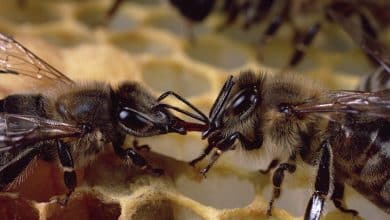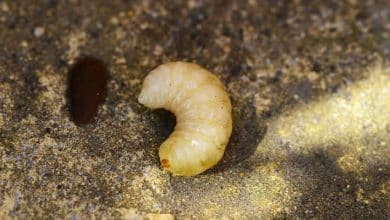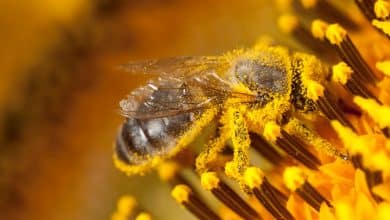Comparing Buckfast Bees to Other Bee Breeds

Buckfast bees are a hybrid selected over a long period of time from many strains of bees from southwestern England. They have been shown to be more resistant to tracheal mites and better suited to the cool climate of that region. These bees have gained a reputation for their unique characteristics and numerous benefits.
In this article, we will compare Buckfast bees to other bee breeds, exploring their characteristics, behavior, productivity, and disease resistance. By understanding the differences between Buckfast bees and other breeds, beekeepers can make informed decisions on which breed to choose for their apiary.
Whether you are a seasoned beekeeper or just starting out, this article aims to provide valuable insights into the world of bee breeds. So, let’s dive in and discover what makes Buckfast bees stand out from the crowd.
Overview of Buckfast Bees and other bee breeds
Buckfast bees are a popular hybrid bee breed that has been selected over time from various strains of bees in southwestern England. They are known for their unique characteristics and numerous benefits. Compared to other bee breeds, Buckfast bees have shown to be more resistant to tracheal mites and better suited to cooler climates.
Other bee breeds come in various subspecies, each with its own characteristics and traits. Some popular bee breeds include Italian bees, Carniolan bees, and Russian bees. These breeds have specific qualities that make them suitable for different climates and beekeeping practices.
When comparing Buckfast bees to other bee breeds, it is important to consider their behavior, productivity, and disease resistance. Buckfast bees are known for being industrious, thrifty, and less likely to swarm. They collect less propolis and maintain a maximum effective colony strength throughout the summer, taking full advantage of the honey flow.
In contrast, other bee breeds may have different behavior patterns and productivity levels. Italian bees, for example, are known for their gentleness and productivity, while Carniolan bees are known for their ability to withstand colder climates. Russian bees are recognized for their disease resistance and ability to handle varroa mites.
In conclusion, understanding the characteristics and traits of Buckfast bees compared to other bee breeds can help beekeepers make informed decisions about which breed to choose for their apiary. Each bee breed has its own unique strengths and attributes, and it is important to consider these factors when selecting the right bee breed for a specific location and beekeeping goals.

Characteristics of Buckfast Bees
Buckfast Bees have several distinctive characteristics that set them apart from other bee breeds. They were carefully selected and bred by Brother Adam, who aimed to create a bee that possessed desirable traits.
One of the main characteristics of Buckfast Bees is their industrious nature. They are known for their hard work and dedication to building and maintaining their colonies. Buckfast Bees are also thrifty, which means they efficiently use resources and are less prone to wasting honey or other materials.
Unlike some other bee breeds, Buckfast Bees are less inclined to swarm. This behavior makes them more manageable for beekeepers, as swarming can result in the loss of bees and the need for additional management efforts. Additionally, Buckfast Bees show greater resistance to diseases such as Acarine, specifically tracheal mites.
In terms of productivity, Buckfast Bees have shown impressive performance. They collect less propolis, which reduces the time and effort required for beekeepers to clean and maintain hives. Additionally, Buckfast Bees have a controlled build-up during winter and rapidly expand their colonies during the appropriate springtime, allowing them to take full advantage of the honey flow during the summer.
Overall, the unique characteristics of Buckfast Bees make them a popular choice among beekeepers. Their industrious nature, thrifty behavior, resistance to diseases, and impressive productivity make them a valuable addition to any apiary.
Unique traits of Buckfast Bees
Buckfast Bees possess several unique traits that set them apart from other bee breeds. They were selectively bred by Brother Adam, who aimed to create a bee with specific characteristics.
One notable trait of Buckfast Bees is their industrious nature. They are known for their hard work and dedication to building and maintaining their colonies. This makes them highly productive in terms of honey production.
In addition to their industrious nature, Buckfast Bees are also thrifty. They efficiently use resources, which means they are less likely to waste honey or other materials. This trait is beneficial for both the bees and beekeepers.
Unlike some other bee breeds, Buckfast Bees are less inclined to swarm. Swarming can result in the loss of bees and the need for additional management efforts. Buckfast Bees show greater resistance to diseases, such as tracheal mites, specifically Acarine.
Furthermore, Buckfast Bees have a controlled build-up during winter and rapidly expand their colonies during the appropriate springtime. This allows them to take full advantage of the honey flow during the summer, leading to higher honey production.
Overall, the unique traits of Buckfast Bees, including their industrious nature, thrifty behavior, resistance to diseases, and impressive productivity, make them a popular choice among beekeepers.
Benefits of keeping Buckfast Bees
Buckfast Bees offer a range of benefits to beekeepers. Their non-aggressive nature makes them easier to handle and work with, ensuring a more pleasant beekeeping experience. Beekeepers can work on the hives without fear of being stung excessively.
The productive nature of Buckfast Bees is another advantage. They have a high honey production rate, allowing beekeepers to harvest more honey compared to other bee breeds. This can result in increased profits for beekeepers.
Additionally, Buckfast Bees have a controlled build-up during winter and rapidly expand their colonies during the appropriate springtime. This means that they can take full advantage of the honey flow during the summer, leading to higher honey production.
Another benefit of keeping Buckfast Bees is their resistance to diseases, such as tracheal mites. This reduces the risk of colony loss and the need for extensive management efforts to combat diseases.
Overall, the combination of their non-aggressive nature, high honey production, controlled build-up, and disease resistance make Buckfast Bees an excellent choice for beekeepers. They offer a rewarding and profitable beekeeping experience.

Characteristics of Other Bee Breeds
Other bee breeds have their own unique characteristics that differentiate them from Buckfast Bees. For example, the Italian bee is known for its gentle temperament, making it a popular choice among beekeepers. They are also highly productive, with a strong honey production rate. However, they can be prone to swarming.
The Carniolan bee is another popular breed known for its gentle behavior and resistance to cold weather. They are excellent foragers and have a strong ability to survive harsh winters. However, they may have a slower build-up in the spring compared to Buckfast Bees.
The Russian bee is known for its high resistance to Varroa mites and other diseases. They are also efficient honey producers and have good winter hardiness. However, they can be more aggressive than Buckfast Bees and require extra care when handling.
The Caucasian bee is known for its longevity and resistance to diseases. They are also excellent honey producers. However, they can be aggressive and defensive, making them more challenging to work with.
Each bee breed has its advantages and disadvantages, and the best choice depends on the beekeeper’s specific needs and preferences. Understanding the characteristics of other bee breeds can help beekeepers make informed decisions when selecting which breed to keep.
Comparison with Buckfast Bees
Buckfast Bees have their unique characteristics that set them apart from other bee breeds. However, when comparing them to other bee breeds, there are some notable differences.
One key aspect to consider is their behavior and temperament. Buckfast Bees are known for their gentle behavior, making them a popular choice among beekeepers. On the other hand, some other bee breeds may have different temperaments and behaviors. For example, the Russian bee can be more aggressive and require extra care when handling.
Productivity and disease resistance are also important factors to consider. Buckfast Bees are highly productive, with a strong honey production rate. They also exhibit good disease resistance, especially to Varroa mites. However, some other bee breeds, such as Italian bees, are also known for their high productivity and disease resistance.
In terms of winter hardiness, Buckfast Bees have shown good resilience. They can survive harsh winters and have a strong ability to build up in the spring. Other bee breeds, like the Carniolan bee, also exhibit similar traits of winter hardiness.
Overall, Buckfast Bees have their advantages, such as their gentle temperament and high honey production. However, other bee breeds may have their own unique strengths and characteristics. Beekeepers should consider their specific needs and preferences when deciding which bee breed to keep.
Popular bee breeds and their characteristics
There are several popular bee breeds that are widely recognized for their unique characteristics. Here are a few:
- Italian Bees: Italian bees are known for their high productivity and honey production. They have a gentle temperament and are easy to work with. Italian bees are also excellent foragers and can build up their colonies quickly.
- Carniolan Bees: Carniolan bees are prized for their winter hardiness and ability to survive in colder climates. They are known for their calm behavior and are less likely to swarm compared to other bee breeds.
- Russian Bees: Russian bees are highly resistant to Varroa mites, making them a popular choice for beekeepers. However, they can be more aggressive in nature and require special handling.
- Caucasian Bees: Caucasian bees are known for their strong sense of self-defense and resistance to pests and diseases. They are well-adapted to colder regions and are known to be prolific honey producers.
- Buckfast Bees: As previously mentioned, Buckfast bees are known for their gentle behavior, high productivity, and resistance to Varroa mites. They are also adaptable and can thrive in various environments.
Each bee breed has its advantages and specific characteristics, making them suitable for different beekeepers and regions. It is important for beekeepers to consider their specific needs and preferences when choosing a bee breed to work with.

Behavior and Temperament
Buckfast Bees are known for their calm and gentle behavior. They have a docile temperament, making them easier to work with compared to other bee breeds. Buckfast Bees are usually less aggressive and are more tolerant of beekeepers’ handling, even in unfavorable weather conditions.
They display a strong sense of self-defense, which means they are less likely to sting unless provoked. This makes them a great choice for beginner beekeepers or those who prefer a less aggressive bee breed. They are also less likely to swarm, allowing for easier colony management.
Buckfast Bees have a strong work ethic, being known for their industrious and thrifty nature. They are diligent foragers and can quickly build up their colonies, maintaining optimal colony strength throughout the summer season. These traits contribute to their high productivity and ability to take full advantage of honey flows when available.
Overall, Buckfast Bees exhibit a calm and cooperative temperament, which makes them a popular choice among beekeepers looking for a friendly and manageable bee breed.
Buckfast Bees behavior and temperament
Buckfast Bees exhibit a calm and friendly behavior. They are known for their docile temperament, making them easy to handle for beekeepers. These bees are less aggressive compared to other bee breeds, and they are more tolerant of being worked with, even in unfavorable weather conditions.
Buckfast Bees have a strong sense of self-defense and are less likely to sting unless provoked. This makes them an excellent choice for beginner beekeepers or those who prefer a less aggressive bee breed. Additionally, they have a lower tendency to swarm, which makes managing their colonies easier.
These bees are also known for their strong work ethic. They are diligent foragers and quickly build up their colonies, maintaining optimal strength throughout the summer season. This high productivity and ability to take advantage of honey flows contribute to their reputation as industrious and thrifty bees.
Overall, Buckfast Bees display cooperative behavior, making them a popular choice among beekeepers. Their calm temperament, combined with their productivity and disease resistance, make them an excellent bee breed for both beginners and experienced beekeepers alike.
Contrasting behavior of other bee breeds
While Buckfast Bees are known for their calm and friendly behavior, other bee breeds exhibit contrasting traits. Some species, such as Africanized bees, are highly aggressive and defensive. They have a quick temper and are more likely to sting when they feel threatened.
Italian bees, on the other hand, have a more moderate temperament compared to Africanized bees. They are generally gentle and relatively easy to work with. However, Italian bees can be more prone to swarming, which can pose a challenge for beekeepers.
Carniolan bees, originating from Slovenia, are known for their gentleness and good winter survival. They are less likely to sting and are considered easier to handle compared to other bee breeds. However, Carniolan bees can also be more prone to swarming, similar to Italian bees.
Buckfast Bees stand out due to their overall docile nature and cooperative behavior, making them a favorable choice for many beekeepers. While other bee breeds may have their unique advantages and disadvantages, the calm temperament of Buckfast Bees remains a desirable trait for those seeking a more peaceful beekeeping experience.

Productivity and Disease Resistance
Buckfast Bees are known for their strong productivity and disease resistance. They have been selectively bred for these traits, making them valuable for beekeepers seeking high honey production and healthy colonies.
One of the reasons Buckfast Bees are highly productive is their foraging ability. They have a strong instinct for collecting nectar and pollen, allowing them to gather resources efficiently. This enables them to produce larger quantities of honey compared to some other bee breeds.
In terms of disease resistance, Buckfast Bees have shown excellent capabilities. Brother Adam, the monk who developed the Buckfast Bee, prioritized breeding for resistance to common hive pests and diseases. As a result, Buckfast Bees have shown resilience against parasitic mites such as Varroa destructor and diseases like American Foulbrood.
However, it is important to note that disease resistance can vary within Buckfast Bee colonies. While they generally exhibit strong resistance, beekeepers still need to implement proper hive management practices, including regular inspections and treatments if necessary, to ensure the health of their colonies.
Compared to other bee breeds, Buckfast Bees‘ productivity and disease resistance set them apart as a reliable choice for beekeepers. Their ability to thrive and produce honey in challenging conditions, along with their resistance to common hive pests and diseases, make them a popular option for both hobbyists and commercial beekeepers.
Buckfast Bees productivity and disease resistance
Buckfast Bees are highly productive and exhibit strong disease resistance. They have been selectively bred for these traits, making them a valuable choice for beekeepers seeking high honey production and healthy colonies.
In terms of productivity, Buckfast Bees are known for their efficient foraging abilities. They have a strong instinct for collecting nectar and pollen, allowing them to gather resources effectively. This enables them to produce larger quantities of honey compared to some other bee breeds.
When it comes to disease resistance, Buckfast Bees have shown excellent capabilities. They have been bred for resistance to common hive pests and diseases like Varroa destructor and American Foulbrood. This resilience against parasites and diseases is a great advantage for beekeepers, as it minimizes the need for invasive treatments and supports the overall health of the colony.
However, it’s important to note that disease resistance can vary within Buckfast Bee colonies. While they generally exhibit strong resistance, beekeepers still need to implement proper hive management practices, including regular inspections and treatments if necessary, to ensure the continued health and productivity of their colonies.
Overall, Buckfast Bees‘ high productivity and disease resistance make them a reliable choice for beekeepers looking to maximize honey production and maintain healthy colonies.
Comparison with productivity and disease resistance of other bee breeds
When comparing the productivity and disease resistance of Buckfast Bees with other bee breeds, it is clear that Buckfast Bees have several advantages.
In terms of productivity, Buckfast Bees are highly efficient foragers with a strong instinct for collecting nectar and pollen. This enables them to gather resources effectively and produce larger quantities of honey compared to some other bee breeds. Their diligent foraging abilities make them a top choice for beekeepers looking to maximize honey production.
Additionally, Buckfast Bees exhibit strong disease resistance, which is a crucial factor in maintaining healthy colonies. They have been selectively bred for resistance to common hive pests and diseases such as Varroa destructor and American Foulbrood. This resilience reduces the need for invasive treatments and supports overall colony health.
On the other hand, other bee breeds may vary in terms of productivity and disease resistance. While some breeds may excel in one aspect, they may lack in the other. It is important for beekeepers to carefully evaluate the specific traits and characteristics of different bee breeds to determine which one best suits their needs.
Overall, Buckfast Bees have proven to be highly productive and possess strong disease resistance compared to other bee breeds. Their efficiency as foragers and resilience against diseases make them a reliable choice for beekeepers seeking healthy and productive colonies.
The comparison between Buckfast Bees and other bee breeds reveals that Buckfast Bees offer distinct advantages in terms of productivity and disease resistance. They excel as foragers, efficiently collecting nectar and pollen, resulting in larger honey production. Moreover, Buckfast Bees have been selectively bred for their resilience against common hive pests and diseases, reducing the need for invasive treatments and promoting overall colony health.
In contrast, other bee breeds may vary in terms of productivity and disease resistance. While some breeds may excel in one aspect, they may lack in the other. Therefore, beekeepers should carefully evaluate the specific traits and characteristics of different bee breeds to determine which one best suits their needs.
Buckfast Bees emerge as a reliable choice for beekeepers seeking healthy and productive colonies. Their diligent foraging abilities and strong disease resistance make them a valuable asset in maximizing honey production and maintaining colony health. However, it is essential to note that Buckfast Bees require proper management to prevent aggression, requiring beekeepers to give appropriate attention to their needs.
In conclusion, Buckfast Bees stand out for their productivity and disease resistance compared to other bee breeds. Their efficiency as foragers and resilience against diseases make them an ideal choice for beekeepers looking for stable and productive hives. By understanding the unique traits of Buckfast Bees and carefully considering their management, beekeepers can enjoy the benefits of this breed while contributing to their local variety of Buckfast Bees.
Pros and cons of Buckfast Bees compared to other bee breeds
Buckfast Bees offer several advantages over other bee breeds. They are known for their high honey production, making them a favorite among beekeepers. Buckfast Bees are efficient foragers, collecting nectar and pollen effectively, resulting in larger honey yields compared to other breeds.
Another advantage is their low inclination to swarm, reducing the risk of losing a colony. Buckfast Bees also have a low inclination to sting, making them more manageable and less likely to pose a threat to beekeepers.
Buckfast Bees are adaptable to various climates, making them suitable for beekeeping in different regions. They have shown high tolerance to tracheal mites, which are common hive pests, reducing the need for invasive treatments and promoting colony health.
However, there are some drawbacks to consider. If left to naturally requeen, Buckfast Bees may become aggressive in the second generation. Beekeepers need to manage their colonies carefully to prevent aggression. Additionally, Buckfast Bees are prone to robbing and drifting, which can lead to the spread of diseases if not managed properly.
Overall, Buckfast Bees offer unique advantages in terms of honey production and disease resistance compared to other bee breeds. However, beekeepers should be aware of their potential aggressiveness and take measures to manage their colonies effectively.
Recommendations for beekeepers.
For beekeepers considering the Buckfast Bees breed, it is essential to make informed decisions. Here are some recommendations to help beekeepers navigate their choices:
- Research and Understand Breeds: Before deciding on a bee breed, beekeepers should thoroughly research and understand the characteristics and traits of different breeds. This knowledge will guide them in selecting the breed that best aligns with their goals and preferences.
- Consider Climate and Local Conditions: Beekeepers should consider the local climate and environmental conditions when selecting bee breeds. Certain breeds, like Buckfast Bees, have demonstrated adaptability to various climates. Assessing the suitability of a breed to local conditions can contribute to the success of the beekeeping venture.
- Seek Advice from Experienced Beekeepers: Beekeepers, especially those new to the practice, should seek guidance and advice from experienced beekeepers. Learning from their experiences and insights can provide valuable information on which breeds are more suitable for specific circumstances.
- Monitor and Manage Colonies: Regardless of the chosen breed, maintaining healthy and productive colonies requires regular monitoring and good hive management practices. Beekeepers should stay proactive in managing their colonies to prevent issues such as robbing and disease outbreaks.
- Attend Beekeeping Workshops and Events: Participating in beekeeping workshops and events can expand beekeepers’ knowledge and improve their beekeeping skills. Such gatherings often offer opportunities to learn from experts, exchange experiences with fellow beekeepers, and gain insights into different bee breeds.
By taking these recommendations into consideration, beekeepers can make well-informed decisions and create successful and rewarding beekeeping experiences.
What are the traits of Buckfast bees?
Buckfast bees are known for their unique and desirable traits. They exhibit a calm and gentle temperament, making them easier to handle for beekeepers, especially those who are new to beekeeping. This characteristic also reduces the chances of aggressive behavior when working with the hives.
These bees are highly productive, with a strong work ethic and an impressive honey production capacity. They are diligent foragers, efficiently collecting pollen and nectar from nearby sources. This productivity makes them a popular choice among beekeepers.
Buckfast bees also demonstrate adaptability to various climates, particularly cool and damp regions. They have been bred to withstand the challenging conditions of southwestern England and have proven resistance to tracheal mites and other pests.
Another notable trait of Buckfast bees is their high disease resistance. They are less prone to common bee diseases, such as varroa mites and foulbrood, making them a resilient breed.
Overall, Buckfast bees possess a combination of favorable characteristics, including docility, productivity, adaptability, and disease resistance. These traits make them an excellent choice for beekeepers who prioritize a stable and productive beekeeping experience.
What is the nicest species of bee?
The nicest species of bee is subjective and can vary based on personal experiences and preferences. However, many beekeepers and experts consider the Italian honey bee (Apis mellifera ligustica) to be one of the friendliest and most gentle species of bees. Italians bees are known for their calm and docile temperament, making them easy to handle and work with. They are less likely to exhibit aggressive behavior, making them a preferred choice for beginner beekeepers.
Italian bees are also recognized for their strong work ethic and efficient foraging abilities. They are excellent producers and have a high honey production capacity. Additionally, they have a good resistance to diseases and pests, including varroa mites.
These favorable traits make Italian bees a popular choice among beekeepers worldwide. Their gentle nature and productivity contribute to a positive beekeeping experience and successful hive management.
It’s important to note that while Italian bees are generally regarded as friendly, individual bee colonies can vary in behavior. Factors such as genetics, environmental conditions, and handling practices can influence the temperament of a bee colony. Regular and proper management, as well as ongoing monitoring of behavior, are essential to maintaining a harmonious relationship with the bees.
What is the most friendly bee?
The most friendly bee is subjective and can vary based on personal experiences and preferences. However, many beekeepers and experts consider the Buckfast bee to be one of the friendliest species of bees. Buckfast bees are a hybrid bee breed that has been selectively bred for their gentle temperament and easy handling.
Buckfast bees are known for their calm and docile nature, making them less likely to exhibit aggressive behavior. They have a low inclination to sting, making them ideal for beginner beekeepers or those who are wary of bee stings. Their friendly disposition also makes them easier to work with during hive inspections and honey harvesting.
In addition to their friendly nature, Buckfast bees are also highly productive. They are excellent honey producers and efficient foragers, contributing to a bountiful honey harvest. They are also cold hardy and can withstand harsh winter conditions, making them suitable for beekeeping in various climates.
While individual bee colonies can vary in behavior, Buckfast bees are generally regarded as one of the friendliest and most user-friendly bee breeds. Their gentle temperament and productivity make them a popular choice among beekeepers worldwide.
What is the calmest bee breed?
The calmest bee breed is often considered to be the Carniolan bee. Carniolan bees, also known as Carnies, are known for their gentle and peaceful nature. They are a subspecies of the Western honey bee and originate from Slovenia.
Carniolan bees have a reputation for being less defensive compared to other bee breeds. They are known to be calm and less prone to aggressive behavior, making them ideal for beekeepers who value a gentle temperament. They have a low tendency to sting, making them suitable for beekeepers who are concerned about bee stings or have less experience handling bees.
One of the reasons for their calm demeanor is their strong sense of hive hygiene. Carniolan bees are excellent housekeepers, known for their diligent cleaning habits and reducing the risk of disease and pests within the hive. This contributes to their overall calm and peaceful nature.
Another advantage of Carniolan bees is their efficient honey production. They are known for their great foraging abilities and can quickly build up hive populations and honey stores. Their productivity, combined with their calm temperament, makes them a popular choice for both beginner and experienced beekeepers.
Overall, the Carniolan bee is widely regarded as the calmest bee breed, making them an excellent choice for those seeking a peaceful and easy-to-handle bee colony.
And there you have it: a comprehensive look at how Buckfast bees stack up against other bee breeds. Their industrious nature, thriftiness, and resilience make them a standout choice for beekeepers, especially when it comes to combating diseases and optimizing honey production.
I hope you found this comparison insightful and helpful. Now, I’d love to hear from you. What are your experiences with different bee breeds? Do you have any questions or additional insights to share about the Buckfast Bees? Let’s keep the conversation buzzing—leave your comments below!




